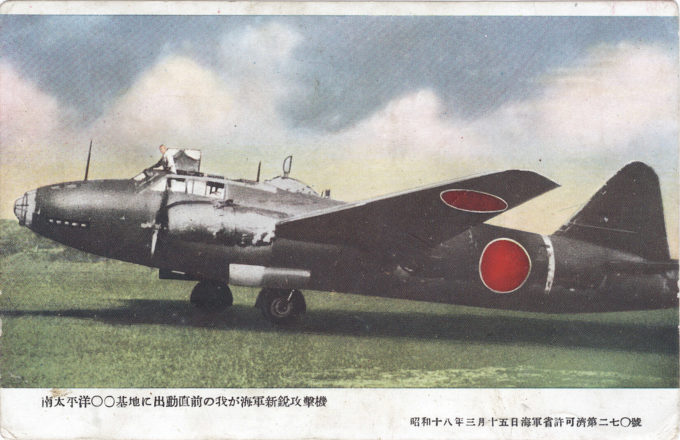
“A riveting new Japanese naval attack aircraft just before its departure for South Pacific Base 00”, I.J.N. Mitsubishi G4M (“Betty”) medium bomber propaganda postcard, 1943.
See also:
Sinking the HMS Prince of Wales and HMS Repulse propaganda postcard, 1941.
I.J.A. Mitsubishi Ki-21 Type 97 (“Sally”) Heavy Bomber, ca. 1938.
Mitsubishi A6M2 “Zero”, c. 1940.
Mitsubishi G1M1, c. 1933.
“The Imperial Japanese Navy Air Service was responsible for long-range bomber and attack aircraft, as well as the strategic air defense of the Home Islands. Toward that end, the Navy distributed a strict specification to Japan’s airplane manufacturers for a bomber to succeed the Mitsubishi G3M already in service.
“The result — the G4M — boasted very good performance and excellent range and was considered the best land-based naval bomber at the time and rapidly turned into the I.J.N.’s primary land-based bomber.
“The G4M became the most widely produced and most famous bomber operated by the Japanese during World War II and it served in nearly all battles during the Pacific War. Attacks by both G4M and G3M bombers resulted in the sinking of the Royal Navy battleship HMS Prince of Wales and battlecruiser HMS Repulse, the first time capital ships actively defending themselves were sunk solely by air power while operating under war conditions in the open sea. G4Ms and G3Ms are also credited with sinking the heavy cruiser USS Chicago during the Battle of Rennell Island.
“The bomber was commonly referred to by Japanese Navy pilots as hamaki — cigar — due to the cylindrical shape of its fuselage … and its tendency to ignite after a hit. It was not until later variants of the G4M2 and G4M3 that self-sealing fuel tanks, armor protection for the crew and better defensive armament was installed. The Allied reporting name was ‘Betty’.
“The G4M would also serve as the mothership that carried the Yokosuka MXY-7 Ohka, a purpose-built piloted anti-ship aerial suicide weapon during the final years of the war. Of the 2,435 G4Ms produced, no fully intact aircraft survived the war although several airframes exist as unrestored wreckage or in partial states of completion.”
– Wikipedia

